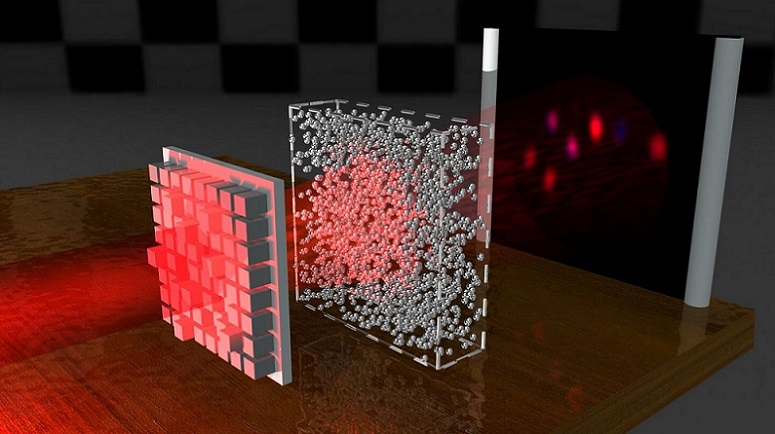A special class of lightwaves possesses the physical qualities that make it able to emerge largely unchanged upon penetrating disordered media. A team from the Vienna University of Technology (TU Wien) and Utrecht University determined that, for any specific disordered medium, tailored light beams can be constructed that are practically unchanged by this medium, and in fact only attenuated. In such cases, the light beam penetrates the medium, and a light pattern arrives on the other side with the same shape, as if the medium were not there.

Artist’s rendition of the experiment. Courtesy of Allard Mosk/Matthias Kühmayer.
The researchers note the potential for the method to be used for imaging procedures in situations where x-ray technology is currently used or where it may be unsuitable.
“Each of these lightwave patterns is changed and deflected in a very specific way when you send it through a disordered medium,” said Stefan Rotter, a professor at the Institute of Theoretical Physics at TU Wien. Rotter and his group developed mathematical methods to describe such light-scattering effects. Allard Mosk at Utrecht University headed a group that produced and characterized the light fields.
The Utrecht group specifically used a layer of zinc oxide — an opaque, white powder of completely randomly arranged nanoparticles — as a light-scattering medium.
The researchers characterized the layer by shining specific light signals through the powder and measuring how they arrive at a detector positioned behind it. From these data, they determined how the medium would affect other waves. They were also able to calculate the distinct wave pattern that was changed by the zinc oxide powder in such a way that it appeared unchanged — as if wave scattering did not exist in the layer of powder.
“As we were able to show, there is a very special class of lightwaves — the so-called scattering-invariant light modes — which produce exactly the same wave pattern at the detector, regardless of whether the lightwave was only sent through the air or whether it had to penetrate the complicated zinc oxide layer,” Rotter said.

“In the experiment, we see that the zinc oxide actually does not change the shape of these lightwaves at all — they just get a little weaker overall,” Mosk explained.
Though these scattering-invariant light modes are rare, with the theoretically unlimited number of possible lightwaves, many of them may be found. Additionally, by combining several of these modes in the right way, they are also able to form a scattering-invariant waveform.
“In this way, at least within certain limits, you are quite free to choose which image you want to send through the object without interference,” said Jeroen Bosch, a Ph.D. candidate at Utrecht University.
In an experiment, the researchers considered the Big Dipper, showing it was possible to determine a scattering invariant wave that sends an image to a detector. This process occurred regardless of whether the lightwave is scattered by the zinc oxide layer.
"To the detector, the light beam looks almost the same in both cases,” Bosch said.
“In hospitals, x-rays are used to look inside the body — they have a shorter wavelength and can therefore penetrate our skin,” said Matthias Kühmayer, a Ph.D. student at TU Wien who worked on the computer simulations of wave propagation. “But the way a lightwave penetrates an object depends not only on the wavelength but also on the waveform. If you want to focus light inside an object at certain points, then our method opens up completely new possibilities. We were able to show that using our approach, the light distribution inside the zinc oxide layer can also be specifically controlled.”
The research was published in Nature Photonics (www.doi.org/10.1038/s41566-021-00789-9).